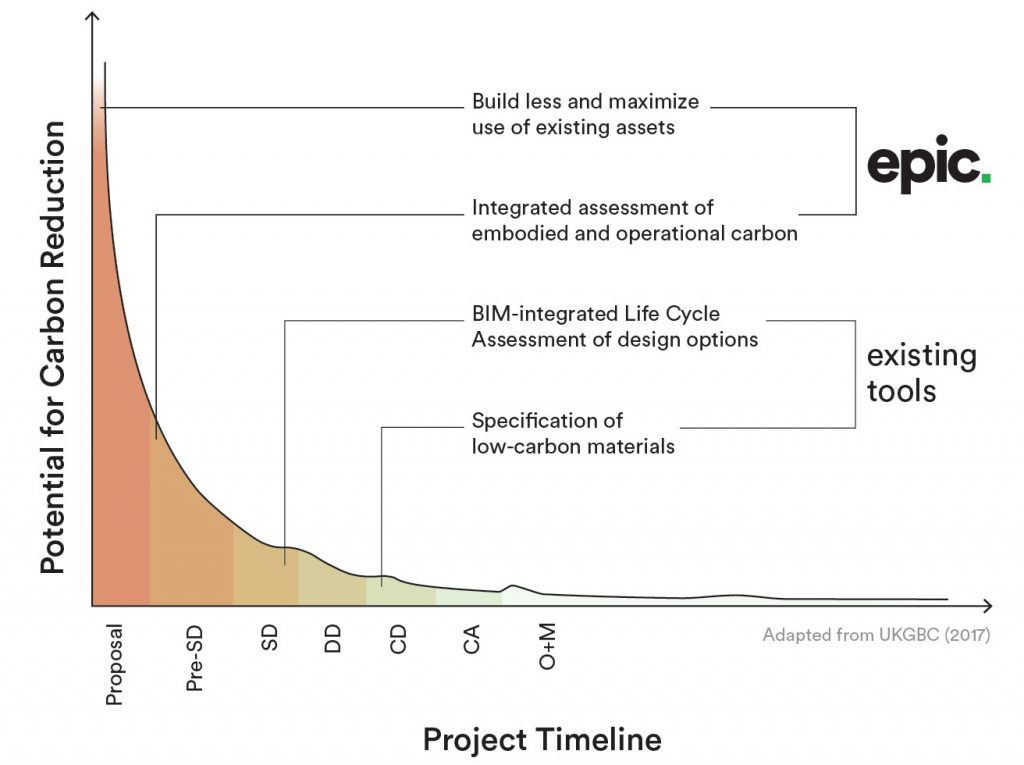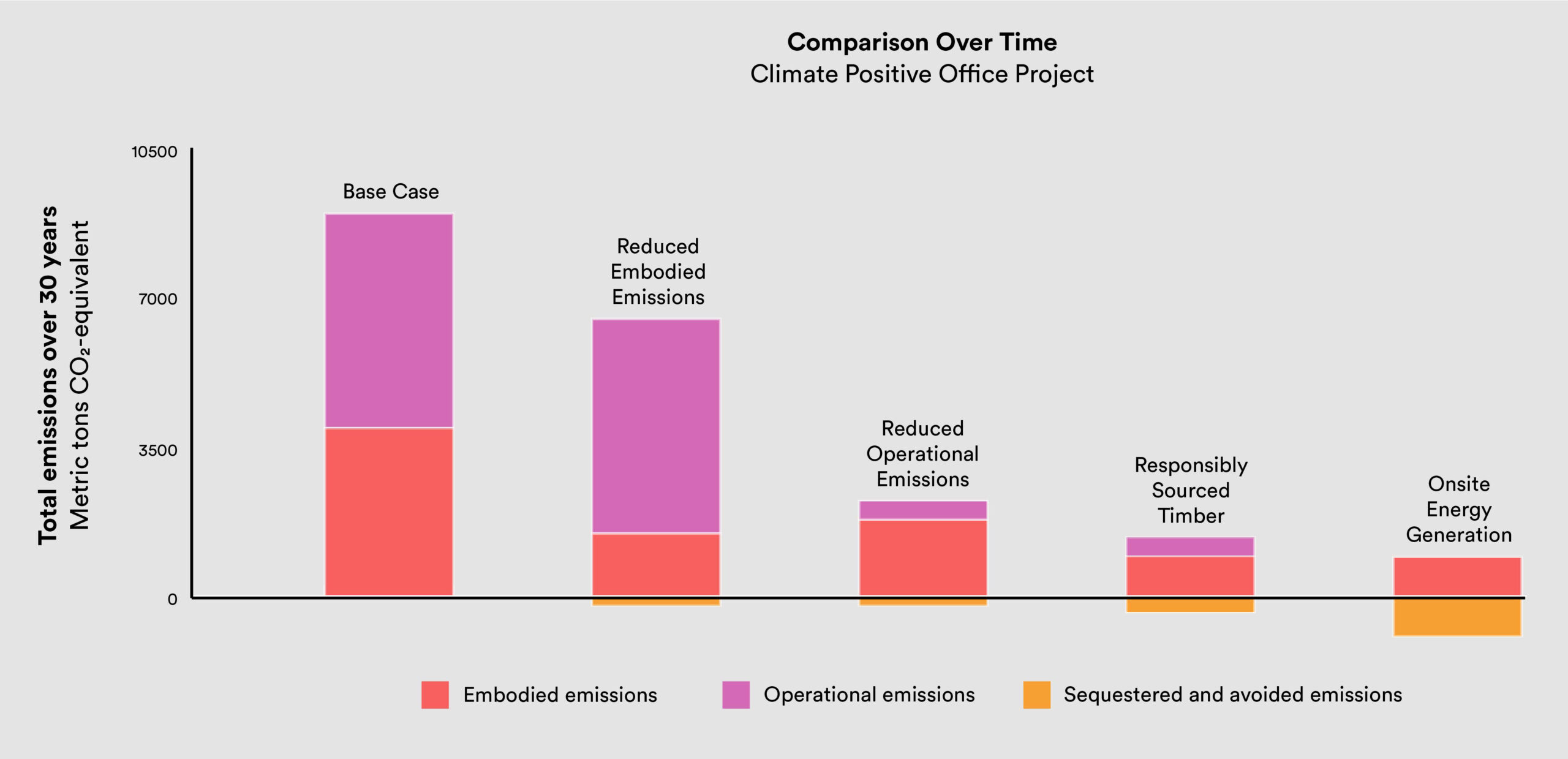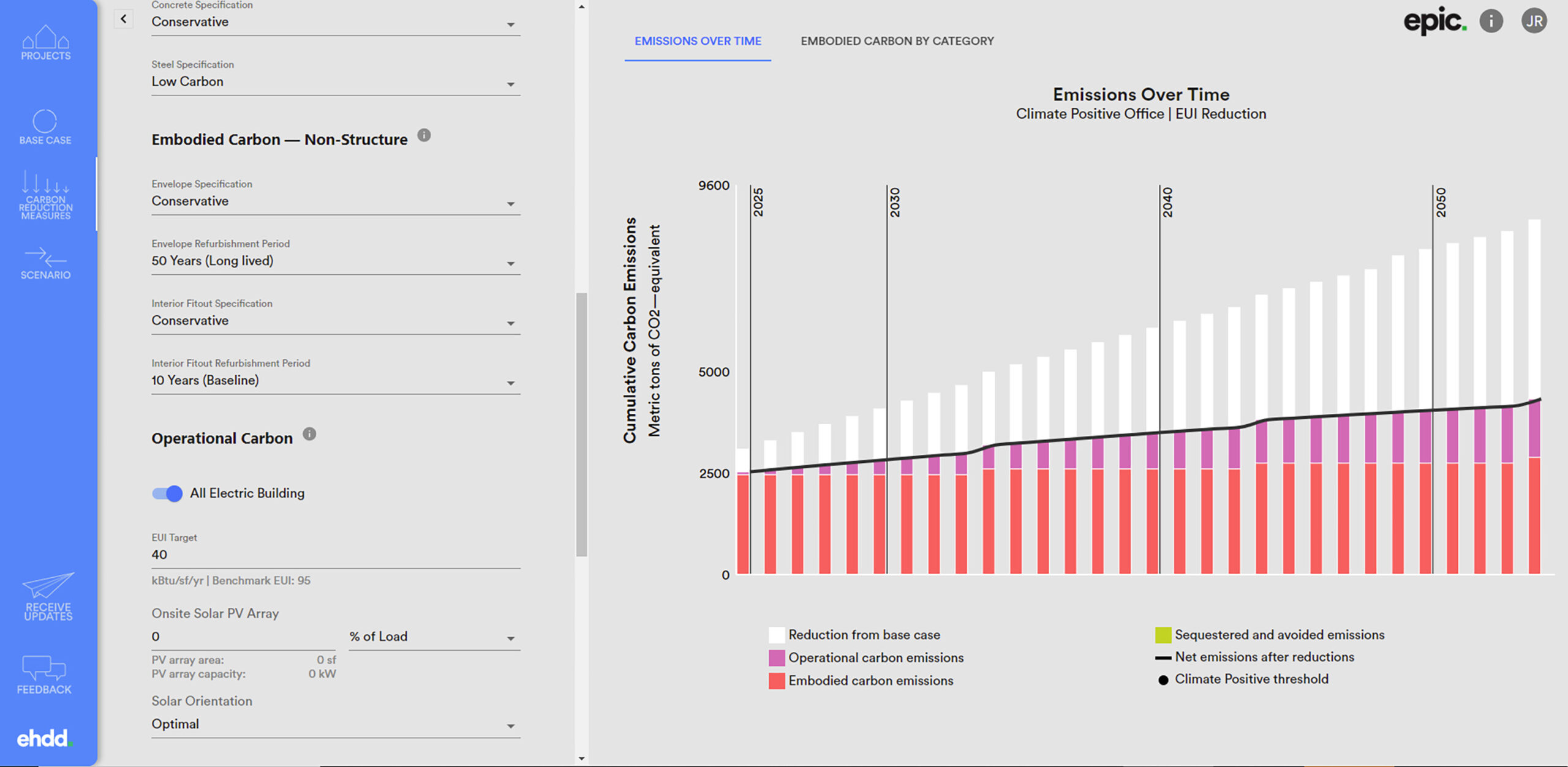Blog Archives
The Case for Architecture in Aquariums
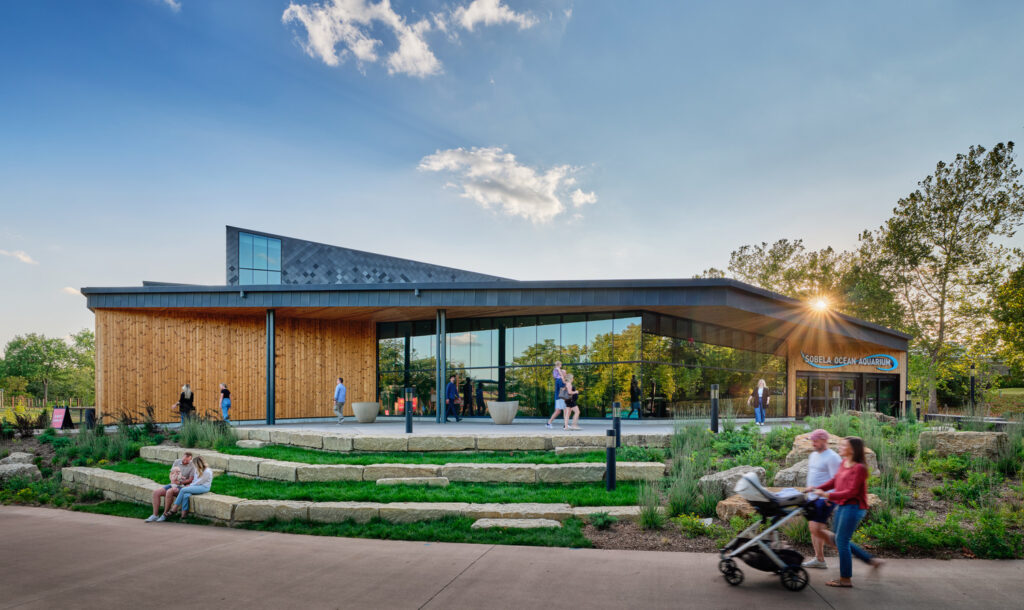
PUBLISHED: NOV. 15, 2023
Kansas City, Missouri, is nearly as far from the ocean as you can get. As my plane descended through an unceasing patchwork of crop squares, the feeling of being completely landlocked set in. I was traveling to Kansas City from EHDD’s San Francisco office, which, in contrast, couldn’t be closer to the ocean. The office sits on San Francisco’s Pier 1, where waves lap against pilons and the shrieks of gulls can be heard in every meeting room. As the design principal for the Sobela Aquarium at the Kansas City Zoo, I had been tasked with bringing this ocean with me, all the way to the Midwest.
The Sobela Aquarium is more than an addition to the zoo—it’s a transformation. Spanning 72,000 square feet, the aquarium offers an indoor, all-season attraction. It catapulted the zoo’s population from 1,700 to over 10,000, and necessitated a complete rebranding of the facility. But the project’s ambition extended further: The facility aimed to ignite a passion for ocean life in its visitors, to inspire a commitment to preserving our natural environment.

Graphic by Yining Ma
In my 15 years at EHDD, I’ve worked on many aquarium projects—from campus planning and concept design efforts to renovations (my first being a historic renovation at the Toledo Zoo) to ground-up projects (such as the one I write about today). And to understand the built landscape these projects fit into, I have visited many, many more. This is what I’ve discovered: Although aquariums are a project type loved by visitors, many have been failed by the design community.
Too much of the aquarium experience can be described as a dark room populated with little blue windows. Or, a common alternative: thematic décor more focused on entertainment than visitor enrichment. While some aquarium buildings are formally expressive, it’s all too rare for the exterior expression to inform the visitor experience.
Does this matter? Is holistic design important to the visitor? To the institution? I would argue yes.
Our clients, like the Kansas City Zoo, want to have a lasting impact on their visitors. They want to move beyond education, to create an experience that will anchor a visitor’s empathy for marine life long after they leave. Of course, the core of this experience is the direct impact of the marine exhibits. But we know that memory is encoded through a more complex sensory experience.
There-in lies the challenge: How can designers use the space to enrich the exhibit experience? To engage all the senses? To encode memories? To bring a true ocean experience to places far from its shores?
Bringing the world’s oceans to Kansas City
In 2018, during the Sobela Aquarium’s predesign phase, we confronted these challenges head-on. Collaborating closely with Space Haus, our exhibit design partners, we assessed the zoo’s initial collection, which included a few staff favorites and a batch of greatest hits: sharks, rays, turtles, tropical fish, octopus, and jellyfish.
The collection represented a broad survey of marine species. To achieve a cohesive visitor experience, we identified a storyline of “marine currents,” an interpretive framework we had yet to see in any peer institution. This storyline lent structure to the global collection, creating an interpretive backbone that highlighted the interconnected nature of our ecosystems. Importantly, the framework informed a progression of spatial and sensory experience—the missing 20% in most institutions. The things that visitors don’t notice that they’re noticing. A visual connection to the outdoors, expansion and contraction of space. Different qualities of light. Temperature and humidity. The feeling of physical descent.
Five years later, I was visiting the Sobela Aquarium just days before it would open to the public. It was time to see if it worked.
Surface
As I stepped inside the Sobela Aquarium, the first thing I noticed was the soundscape. It was alive: Tamarins trilled, toucans croaked, and a crash tank mimicked the arrhythmic crashing of waves against the shore. The space was warm, not just the temperature, but the stream of natural light glinting on the rockwork. The humidity pricked my skin, and the faint smell of salt drifted from the salt marsh habitat. I was immediately immersed in the exhibits, in a way that felt inviting, not jarring. Meandering between several pools with waist-high water, I found myself descending.
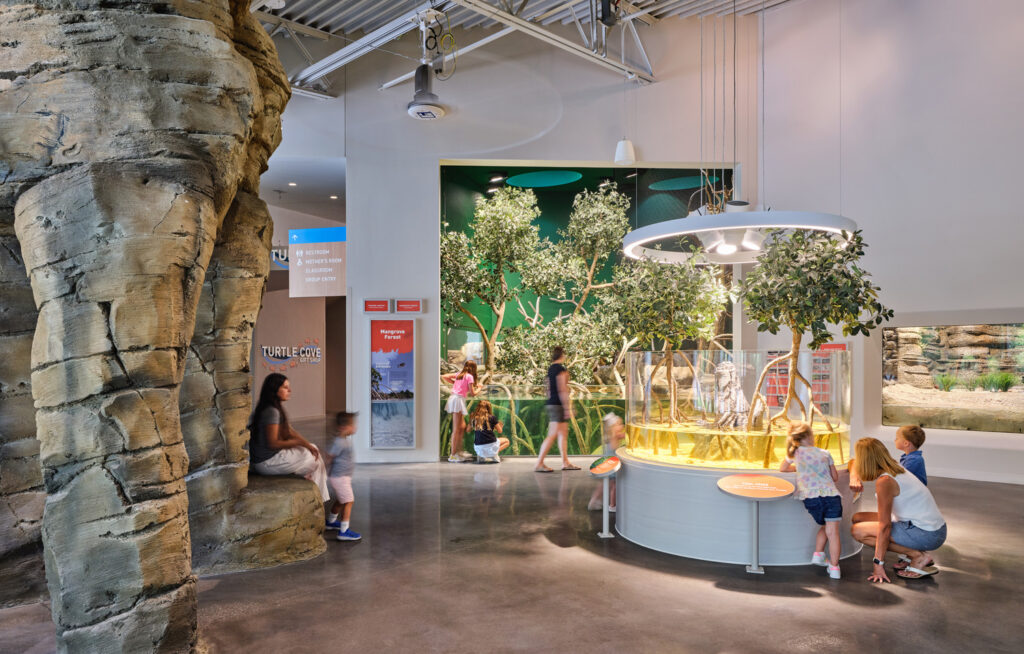
Shallows
The water levels shifted, from waist level to just above my head, and the physical descent down a ramp reinforced the sense that I was wading deeper into the ocean. As the scale of space and exhibit size increased, I started to feel small. The soundscape became less chaotic; the calls of birds and monkeys faded, replaced by more muffled aquatic sounds. Water warmed my hand as I dipped it into the touch tank. The light was dappled, streaming through a perforated screen from the clerestories above. A sea turtle lazed by at eye level, quickly overtaken by a reef fish racing through the vibrant tropics dropped into the heart of Kansas City.
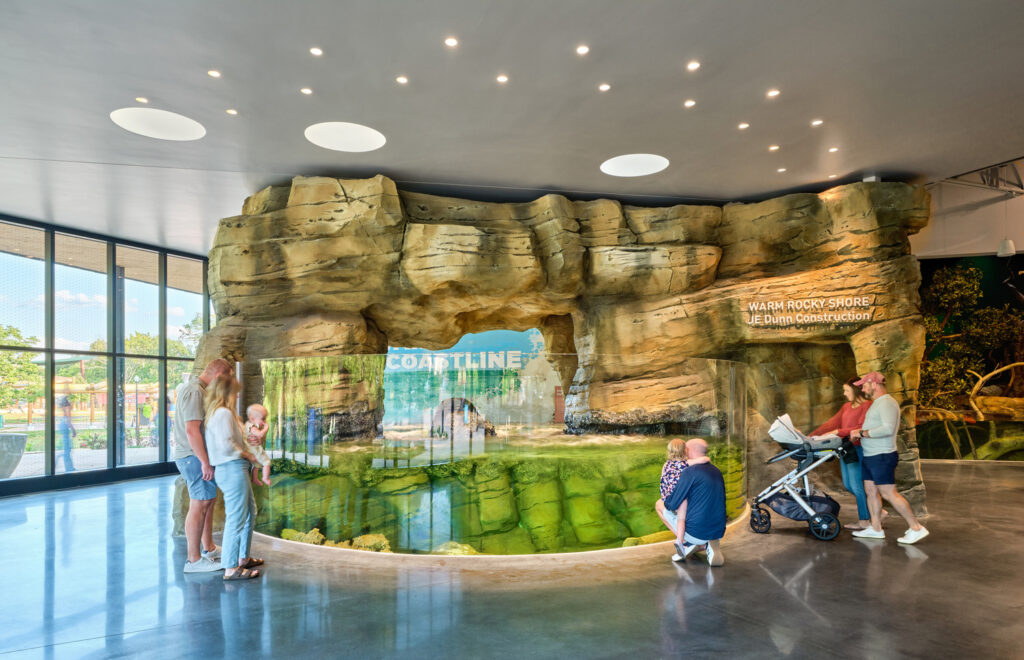
Submersion
Slipping through a slender threshold into a darker space, I immediately noticed light dancing on the floor. I looked up, and a school of pilchard swirled above. It was quieter here. The carpeted floor dampened the sound of footfall, and large concrete walls sapped the warmth of the earlier galleries. I rounded the corner, coming face to face with a Napolean Wrasse. Based on his expression, I was more impressed with him than he was with me. I took a step back and saw him in his full context: a boundless ocean with a vibrant community of life. Stepping down into a tiered viewing area, I followed the cold gaze of a shark as it glided overhead. I felt the weight of thousands of gallons of water above me.
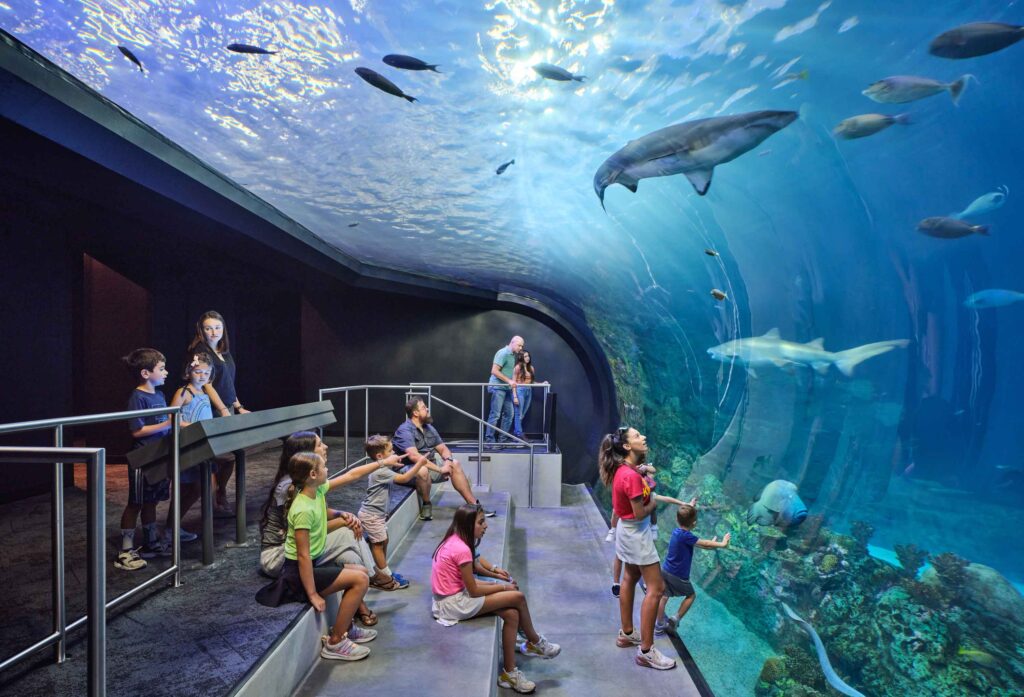
Depths
The next space felt like a reset. It was different, somewhat alien and a little disconnected. As I crossed a gateway of gravity-defying jellies, the space opened to an amorphous volume. A soft glow of light above offered a feeling that my normal life was up there somewhere. But down here, I was quick to discover spider crabs, giant isopods, and other oddities of the deep ocean.
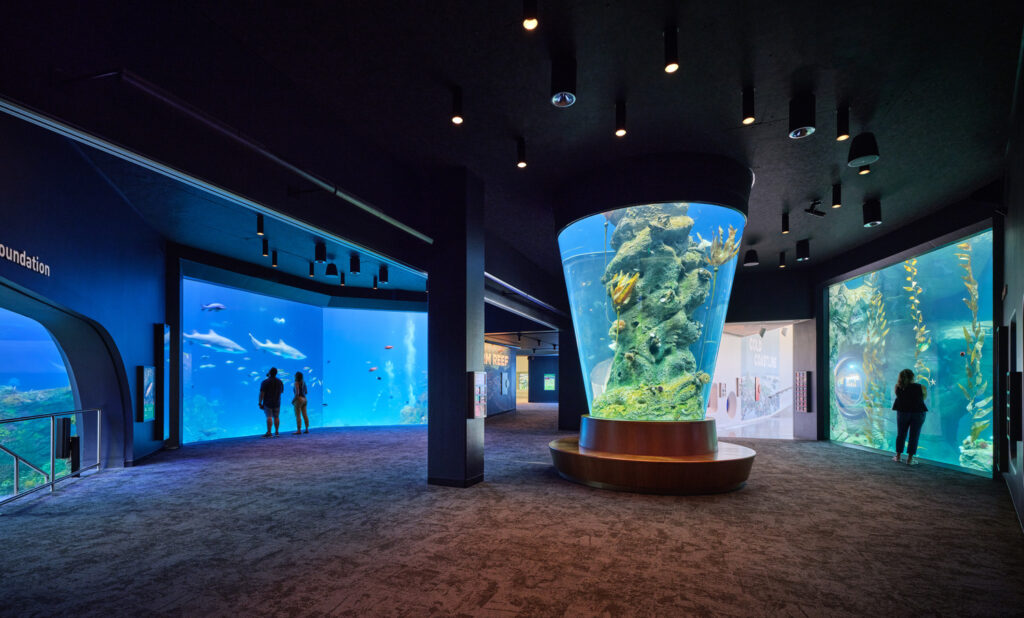
Ascent
In the next space, things felt lighter. The volume of the space expanded. Light streamed in through a large kelp window and a conical eel tank sprang weightlessly from the center of the room. A soft bounce of daylight beckoned ahead.
Emerge
Rounding the corner, the otters took center stage, summersaulting over and under the water’s surface, occasionally hopping up “on shore” to glimpse the trees beyond. The ever-changing sky as the backdrop for these charismatic fellows anchored the feeling that we had resurfaced. Ascending a ramp that approached the final exhibit—a cold water touch tank—the ceiling peeled open to a north-facing clerestory that offered a cool brightness to the gallery below.

Creating resonance one design choice at a time
As the visitor path brought me full circle, back to the entryway, I was struck by the experience. All visitors to the aquarium will notice the animals, and many will notice their habitats. Few will consciously recognize the impact the quality of space has on their connection to these key features. But it is this layering of the experience—the hundreds of small design choices made over the course of the project—that can make a visitor’s experience so rich, varied, and engaging. This is the intangible element that creates memories and elevates an experience from enjoyable to resonant.
Beyond EUI: EHDD’s AIA 2030 Commitment Evolution
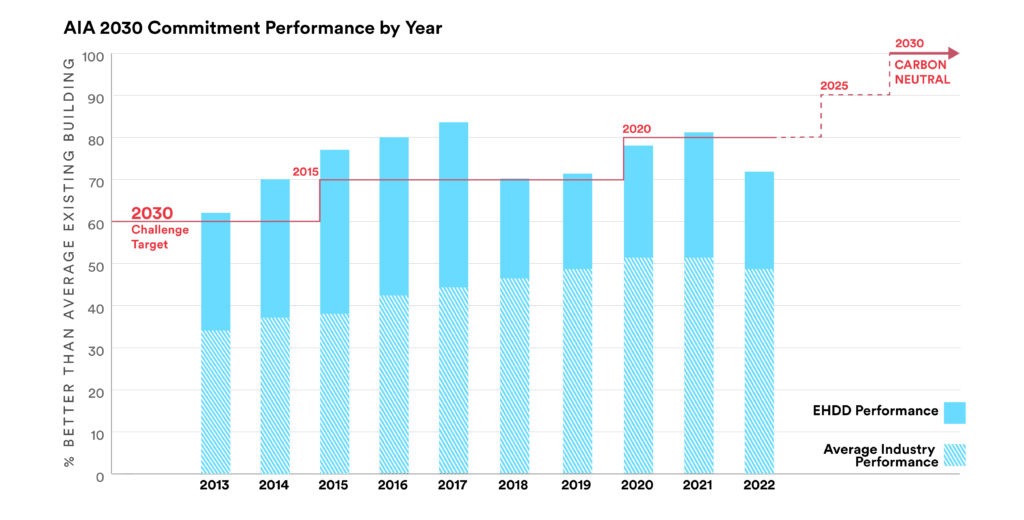
Published: Oct. 27, 2023
In April of this year, Michelle Amt at VMDO wrote an inspiring article about being radically transparent in their journey toward achieving the goals set by the American Institute of Architects’ (AIA) 2030 Commitment. We recognize Michelle’s courage and integrity in making such a post and wanted to honor those ideals by publicly sharing the results from our 2022 portfolio.
EHDD & the AIA 2030 Commitment
EHDD has been a signatory to the AIA 2030 Commitment for over a decade. During that time, we have been an industry leader in achieving the goals set by the challenge and have met AIA targets for 8 out of 10 years since we started reporting in 2013.
In 2022, our firmwide average performance declined by approximately 10% compared to our 2021 performance, missing the AIA 2030 target. We are digging into the data to better understand why this is, including examining performance data by project type. For instance, we see that our student residence halls lagged behind the Energy Use Intensity (EUI) reduction of some other project types; meanwhile, the percentage of our work represented by student housing jumped up substantially in the last few years. Going forward, focusing more attention on student housing performance is a priority.
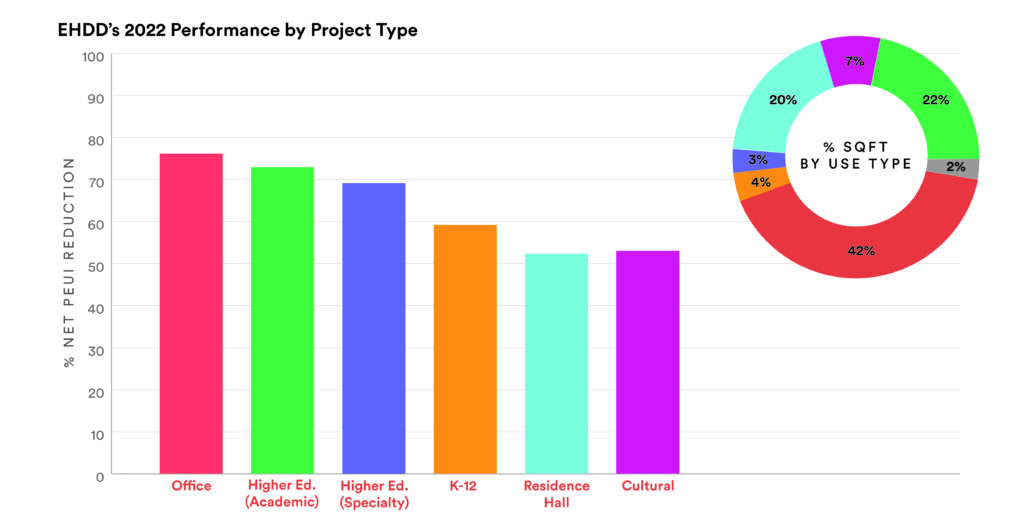
Decarbonization is the new EUI
At the same time, the AIA 2030 program is evolving in a significant way that aligns with our own shift in focus to decarbonization and EHDD’s commitment to a Climate Positive future.
EHDD’s aim is to eliminate fossil fuel use from our projects, support grid electrification, reduce energy use within realistic limits, and address embodied carbon. This shift is clearly evidenced by two significant projects included in our 2021 and 2022 portfolios, the AIA National Headquarters in Washington, D.C., and the YouTube Campus Expansion in San Bruno, California. Both projects relied on a mix of on-site and grid-provided renewable energy to achieve the AIA 2030 targets.
The AIA National Headquarters is an existing building renovation that achieved robust improvements in energy performance with a gross pEUI of 32 and included as many onsite renewables as could fit on the site. Operational carbon neutrality was achieved through the purchase of fully additional renewable power from the D.C. power grid. Similarly, our YouTube Campus Expansion in California combines extensive onsite renewables, a microgrid with battery storage, and offsite renewables to achieve zero carbon operation.
Additionally, in our work on Sonoma Clean Power Headquarters, EHDD has also been considering how patterns of energy use can be as important to reducing carbon emissions as the total amount of energy used. This GridOptimal pilot project shifts energy use to times when the grid has higher levels of generation from renewables—such as during the day when the sun is shining—orienting us toward a future where buildings are a resource, not a burden, to the electrical grid. This strategy also has the potential to reduce time-of-use electricity rates, resulting in both carbon and cost savings while taking the pressure off the grid.
Analysis using our EPIC tool shows that combining electrification and efficiency can reduce emissions beyond efficiency alone. As our research summary shows, while electrification achieves only a 25% reduction in energy use, it achieves an almost 80% reduction in carbon emissions. From a carbon perspective, it’s much more impactful to push for all-electric power than for a slight improvement in efficiency. This is true in various locations and across diverse project types.

The approaches for these projects align with the recent changes in the AIA 2030 Commitment reporting system that allows for counting legitimate (additional & dedicated) off-site renewables as negative EUI to offset operational energy. This change highlights a shift from thinking purely about energy reduction to one that aims to decarbonize the entire building stock while supporting the energy grid’s shift to renewable generation. A shift to focusing on carbon can help projects that cannot achieve an extremely low EUI (especially existing building retrofits) and that cannot accommodate significant onsite renewables to still meet the intent of the AIA 2030 commitment and contribute to the scalability of decarbonized energy.
The AIA’s 2030 Design Data Exchange (DDx) now invites firms to report on embodied carbon data. Both of the EHDD projects highlighted above also underwent significant embodied carbon reductions with analysis through full life-cycle assessments. While this was tracked in the AIA 2030 DDx, it does not currently contribute to the portfolio’s percent reduction number — an accounting metric we hope to see reflected in future iterations of the 2030 reporting.
We applaud the continuing efforts of the AIA 2030 Working Group to move the program away from EUI and toward fossil fuel reductions across operational and embodied emissions. And while our firm would like to be meeting the 80% reduction goal today, we are confident that by addressing carbon broadly in our projects, EHDD is on track to meet the ultimate goal of zero emission buildings by 2030.
Work-Life Balance: Transforming Downtown for a New Era
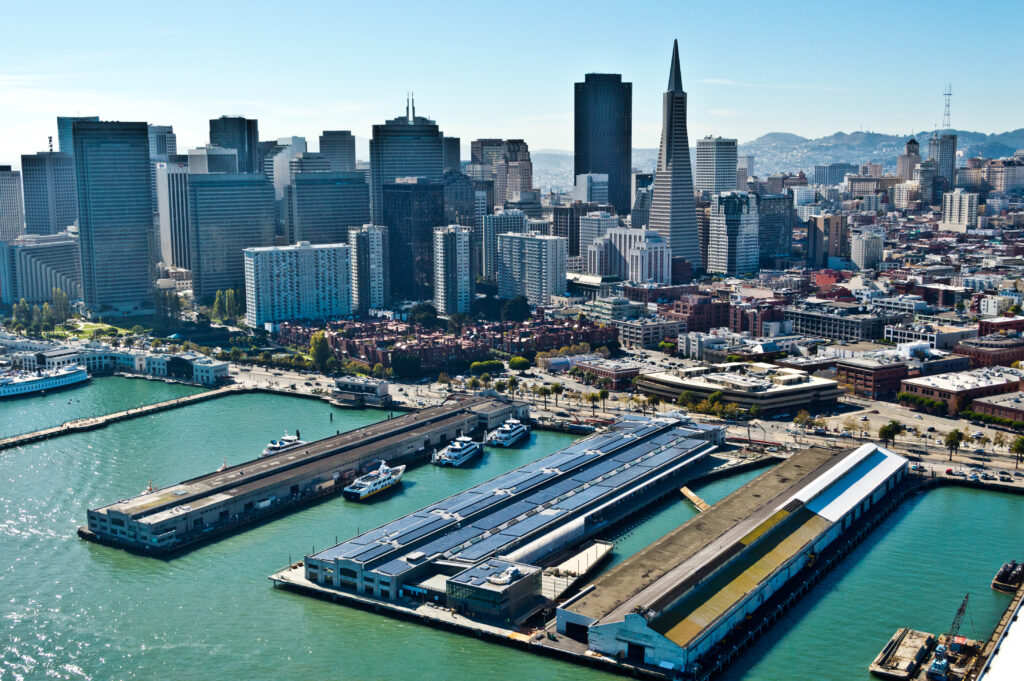
Published: Oct. 16, 2023
The Pandemic-fueled disruptions to how and where we work have denuded our downtowns of life. The 27% office vacancy rate in San Francisco is a 50-year high — the equivalent of sixteen Salesforce Towers sitting empty. Downtown Seattle, EHDD’s other home base, is close behind, at 22%. The economic impacts go far beyond the professional and tech workers who are the face of the exodus; in fact, the highest employment of people of color in San Francisco is in downtown.
A Pattern through the Decades
I grew up in New York City in the 1970s as it teetered on the edge of bankruptcy. The same concerns over disorder, cleanliness, and declining tax base characterized the conversation… or at least as I understand it now. Back then, I was enjoying my childhood, riding extremely well-graffitied subway cars and dutifully avoiding Central Park at night. The 21st century urban renaissance that came to post-9/11 New York and other downtowns would have been an impossibly sanguine vision from that point in time.
We have a tremendous opportunity now to recreate downtown Seattle and San Francisco into more resilient, mixed-use, and livable districts. There are many obstacles to overcome in transforming underutilized office buildings for residential and other uses, but the upside is tremendous.
Here, I will briefly summarize the current conversation on this topic, add EHDD’s perspective building on our decades of “Transformations” work, and suggest pathways to overcome challenges to actualization.
The Value Proposition
Through concerted action, we can achieve a triple-bottom line, mutually reinforcing benefits such as:
- Revive urban economies by creating 24/7 downtown hubs of activity
- Increase both market-rate and designated affordable housing supply and meet our California “Housing Element” commitments
- Speed the transition to an all-electric, decarbonized economy through wholesale modernization of outdated office buildings
- Avoid upfront, embodied emissions associated with new construction and create a real pathway toward creating zero emissions built environment
- Support contemporary lifestyles and demographics through diverse unit types matched to unique existing footprints
The challenges are threefold: economic, regulatory, and technical. Let’s break them down:
Economic
According to a NAIOP report, office-to-residential conversions are typically 15 to 20% less expensive than new construction and are faster to complete. I’d say the range is more like 0 to 50%, depending on a host of factors. But while construction costs may be beneficial over new construction, at the current moment, office building valuations are generally still far too high to pencil out for conversions, even in Class C buildings.
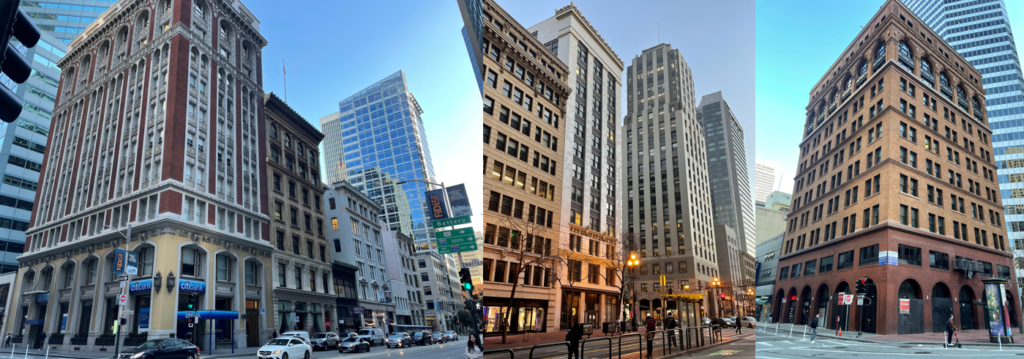
One San Francisco developer deeply pursuing this market shared that valuations are still 2x where they would need to be to make financial sense; the valuations need to retreat to just above the land costs to warrant a full seismic/reuse retrofit. That time may in fact be approaching as vacancy rates continue to rise.
And of course time, not to mention taxes and fees, is money as well. The head start afforded by a built structure, and the regulatory incentives (which I discuss further on) that may emerge could flip the script soon enough.
Regulatory
The regulatory context is ripe for advocacy, and action may be in the works. In San Francisco, for instance, the 2022 Housing Element Update just gained state approval, which commits us to build 82,000 new units of housing by 2031. This is triple the rate of recent housing development in the city. Various city agencies and leaders are working under Mayor London Breed’s direction to streamline processes, rezone many areas, and consider modifications to both Planning and Building codes.
San Francisco has the second-highest concentration of office use of any downtown. The mayor is exploring whether we can diversify this district; she directed the Planning Department to develop a plan by April 1, 2023, to ease the conversion of office buildings to residential use.
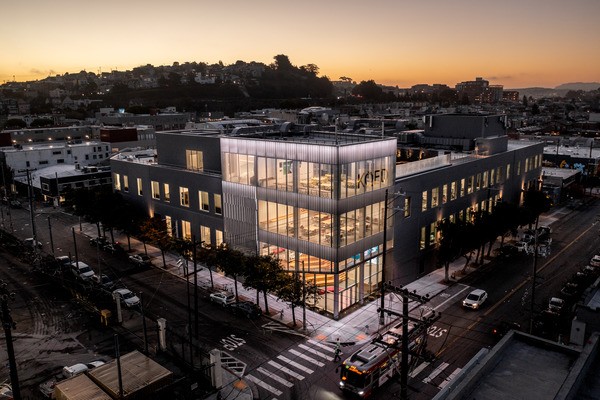
One possibility is the relaxation of certain requirements previously extended to developers of ADUs (accessory dwelling units) for things like open space and rear yard access, which will typically be impossible to meet in existing office buildings. Building code requirements around exit distances and fire escapes may also need to evolve to address existing conditions. Local politicians are acting: Aaron Peskin, the Supervisor representing the Financial District, is currently analyzing the building stock to identify good candidates for conversions.
Technical
Despite healthy skepticism by many, office-to-residential conversion can work under the right circumstances, and downtowns can be attractive places to live. Seattle was already one of the fastest-growing residential downtowns in North America: in the 1980s, 20,000 people lived downtown; but by 2020, downtown boasted 100,000 residents. Seattle’s neighbor Tacoma is a leader in office-to-residential conversions.
A 10-story tower currently being converted to residential is the fourth such conversion project in their downtown, characterized by historic office buildings built at a time when light and air came through windows, not HVAC systems. We can build on these trends and successes there and elsewhere. Targeting older buildings with smaller floor plates not well suited to the modern flexible office is certainly the first place to start.
Lessons from The Cannery
The technical issues of reuse are a familiar and welcome challenge to EHDD’s office. In 1909, The Cannery at Fisherman’s Wharf in San Francisco was the largest fruit and vegetable canning plant in the world and the center point of the company that became Del Monte Foods. The Great Depression caused all production to cease and led to decades of spotty use as a warehouse. In the 1960s, a developer named Leonard Martin purchased the building with the intent of creating “an environment reminiscent of the romantic marketplaces of Europe.”
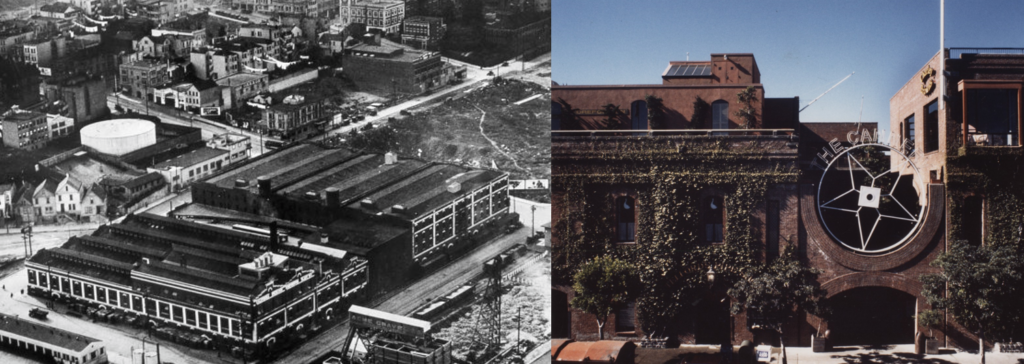
The founders of EHDD, especially Joe Esherick and Peter Dodge, designed and executed the developer’s vision, creating a new archetype of the “festival marketplace” that leverages historic architecture in a great location with a fully reimagined use for a new era. Across the street at the same time, William Wurster was similarly transforming Ghirardelli Square into a beloved tourist destination.
Cities are, by their nature, resilient, and architects like those at EHDD have always played a key role in turning the crisis of sudden change into opportunity. Since the Cannery, we’ve honed our design skills and knowledge around building transformations; today more than half of our projects include significant reuse. And we’ve shown on projects like The Exploratorium, KQED Headquarters, UCSF’s Clinical Sciences Building at Parnassus, and our in-progress AIA National HQ Renewal in Washington, D.C., that a rich existing context can provide greater design and impact opportunity than an all-new project.
Most buildings we will occupy in the coming decades already exist today. Our Climate Positive commitment puts building transformation front and center as perhaps the key building climate strategy to allow us to keep climate change below 1.5-degrees Celsius. Nothing is more immediately impactful than avoiding upfront, embodied carbon emissions of new structures by adapting older buildings for new uses. This, coupled with deep efficiency and decarbonization retrofits, is the recipe for achieving our commitments.
We look forward to a resilient, vibrant, equitable, climate positive future for our downtowns by 2030 and to partnering with our wide community to get there.
EHDD Advances Climate Action in Architecture with Canadian Expansion of EPIC Tool
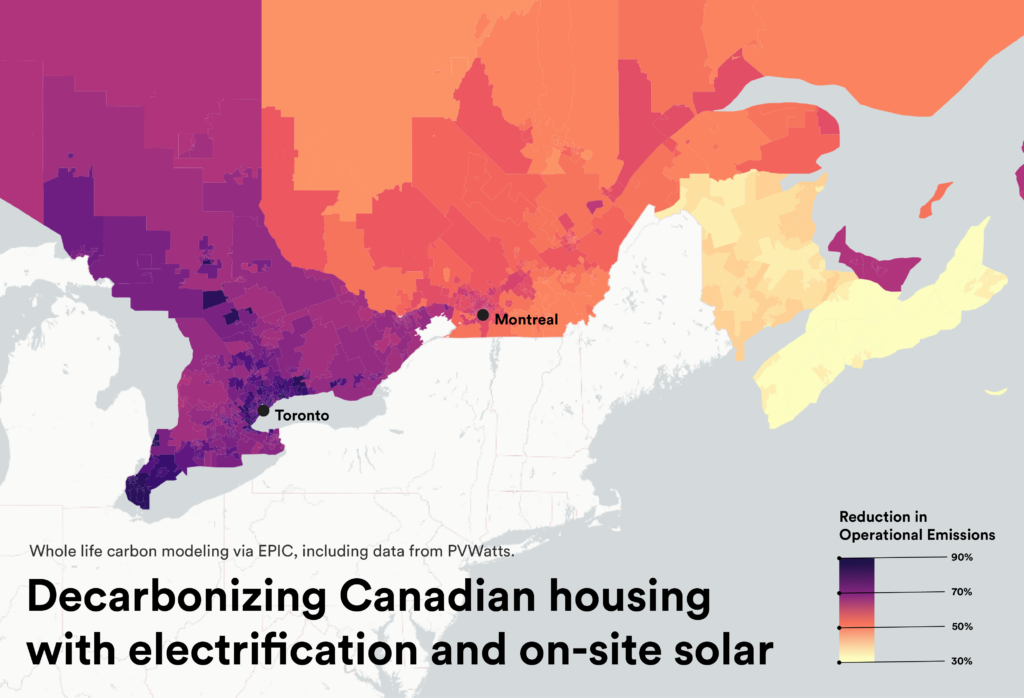
Published: Oct. 12, 2023 | FOR IMMEDIATE RELEASE
EHDD, a pioneer in climate-positive architecture, has announced the expansion of the Early Phase Integrated Carbon (EPIC) assessment tool to support Canadian users, enhancing the regional specificity and international reach of the application. With this update, EHDD continues to break barriers in sustainable design by adapting to regional building characteristics, energy sources, and climate conditions, ensuring the accuracy and reliability of embodied carbon calculations.
“Climate impacts don’t stay within national boundaries,” said Brad Jacobson, FAIA, a Principal at EHDD. “Our EPIC tool will increasingly reflect the global nature of this challenge and, at the same time, the regionally specific solutions that are most impactful on any given project.”
Launched in 2021 as a free web application, EPIC has been embraced by nearly 3,000 professionals across architecture and engineering firms in the United States, alongside a growing number of users outside the AEC industry, including real estate developers and environmental, social, and governance (ESG) investors. The tool aids design teams in determining the most effective strategies for carbon emissions reductions in the early stages of a project, a critical time when data might be scarce but the opportunity for impact is significant.
EHDD identified a growing need for EPIC in Canada, where cities like Vancouver and Toronto have enacted embodied carbon reporting legislation. Before the update, many EPIC users were employing complex workarounds to adapt the tool for Canadian buildings.
“The manufacturing of concrete, the building stock, the electric grid — all these factors that impact a building’s whole life carbon — are regionally specific, and we’ve upgraded EPIC to reflect those regional differences across Canada,” said Jack Rusk, director of Climate Strategy with EHDD.
The update is set to streamline the process, providing Canada-specific results and addressing the unique aspects of the Canadian building stock, energy grids, and material manufacturing. The Canadian update uses a combination of government data sources, industry white papers, and peer-reviewed literature, ensuring that the Canadian data is internally consistent and comparable to results from the United States.
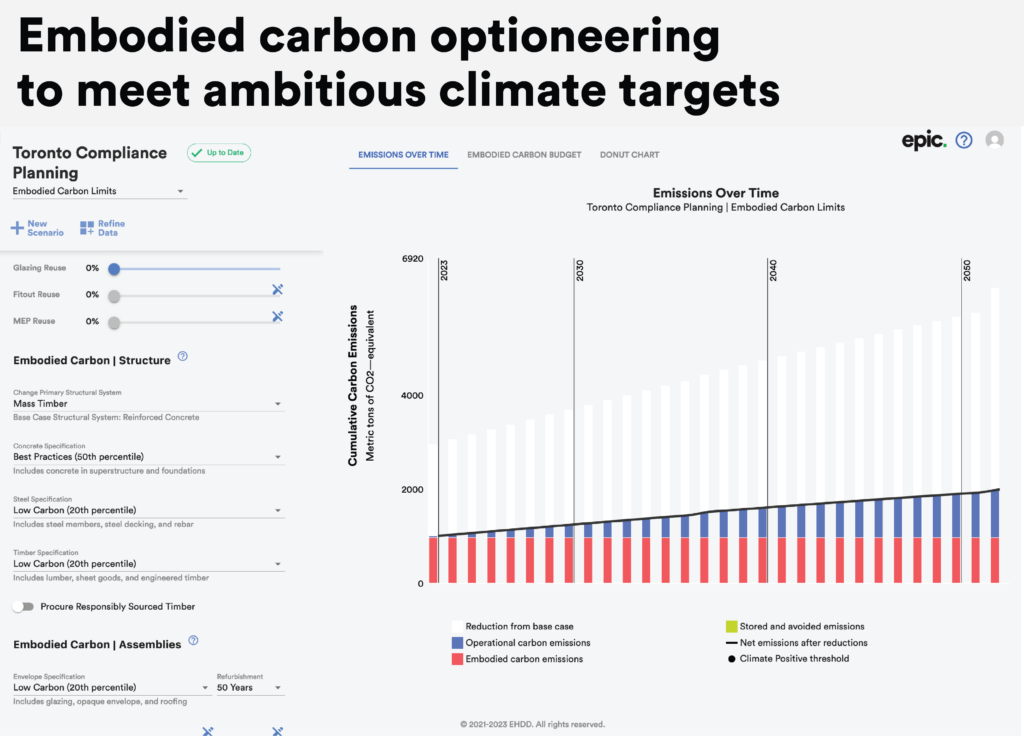
This expansion also lays the groundwork for further internationalization, addressing embodied carbon reporting requirements in various countries. “We’re building the data infrastructure necessary to describe the nuances of each region, with the goal of a tool that can support users with global portfolios,” said Lalyn Yu, Research Specialist with EHDD.
In addition to the geographical expansion, the EPIC tool has been upgraded to include building emissions from refrigerants, a significant yet often overlooked aspect of building-related emissions. EHDD believes in encompassing all real emissions related to buildings and is working closely with a team of industry experts and non-profit advocacy organizations to refine assumptions and strategies around refrigerant emissions.
EHDD’s dedication to climate action and sustainable architecture is evident through the continuous improvement and expansion of the EPIC tool. By making EPIC free and available to all, EHDD fosters a collaborative environment in the pursuit of a sustainable future, pushing the boundaries of conventional design practice.
For further information, please visit EPIC Assessment (ehdd.com).
About EHDD
EHDD is an award-winning architecture firm with a strong commitment to advancing climate action through sustainable design. With decades of experience and numerous successful projects, EHDD creates transformative places of belonging and impact.
From the Sea Ranch Archives
In 1964, to demonstrate workable designs for The Sea Ranch, developer Oceanic Inc. commissioned Joseph Esherick & Associates to design a series of single-family homes nestled within an existing cypress hedgerow. At the same time, the Moore, Lyndon, Turnbull, and Whittaker (MLTW) architectural group was designing Condominium One. Landscape architect Lawrence Halprin had proposed that housing at The Sea Ranch adopt a cluster model in order to preserve open space, with units either closely bound in a single entity or connected more loosely in the manner of a farmyard. Condominium One demonstrates the former approach, the Hedgerow Houses the latter.
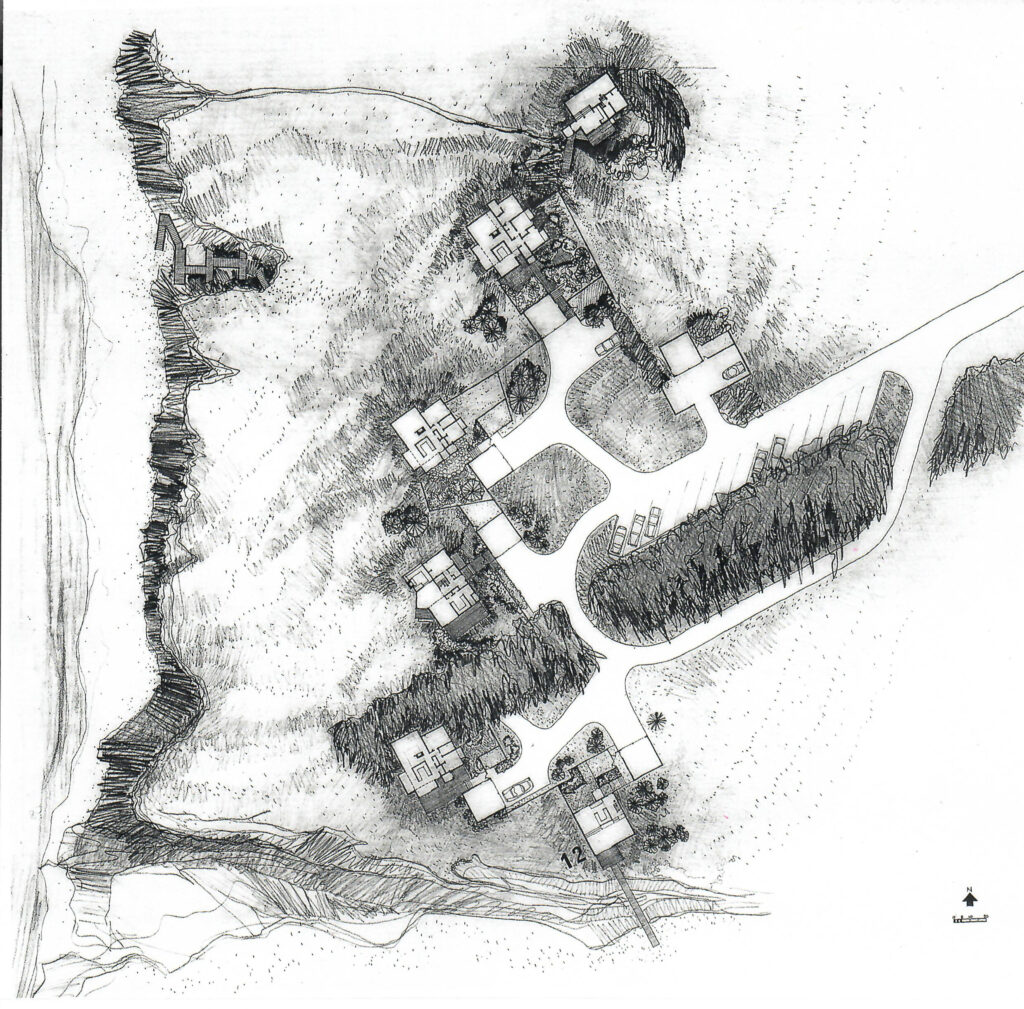
Caption: Final site and floor plans for the Hedgerow Houses at The Sea Ranch.
According to George Homsey, a member of Esherick’s firm and principal designer of many of the firm’s Sea Ranch homes, Esherick selected the most challenging of sites on the bluff overlooking Black Point Beach, out in the wind on the lower edge of the protective hedgerow. He thought if a design for these sites could accommodate the wind and harsh ocean weather, then the design would work anywhere at The Sea Ranch. Thus, along with MLTW, Esherick defined the Sea Ranch style.
Homsey also explained that different designs were proposed and tested utilizing a wind tunnel to determine which would work best in the strong wind at the site. The simple shed roof that provided for the wind to flow over roof and adjoining hedgerow proved the most effective. Esherick later pointed out: “Just look at the cypress trees that bend in the direction the wind blows – a model for a workable roof line.”
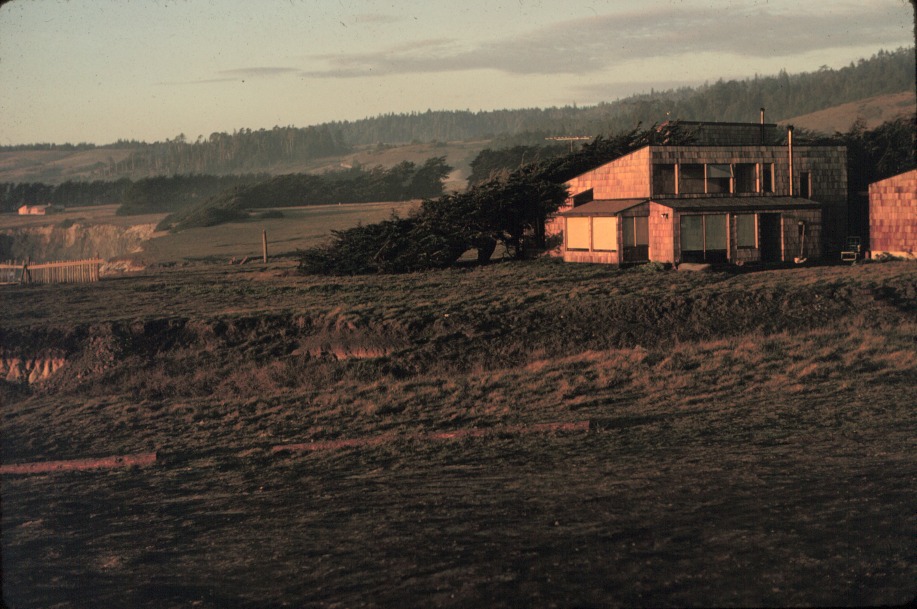
Caption: Taking cues from the landscape, the roof of this Hedgerow house slants in alignment with existing cypress trees.
A protected patio on the leeward side of hedgerow and/or house was built for each dwelling, with the wind carried over the patio. Clerestory windows face south to capture the morning sun. Fences between houses, as well as their free-standing double garages, create private spaces for each unit while simultaneously giving identity to the cluster as a whole.
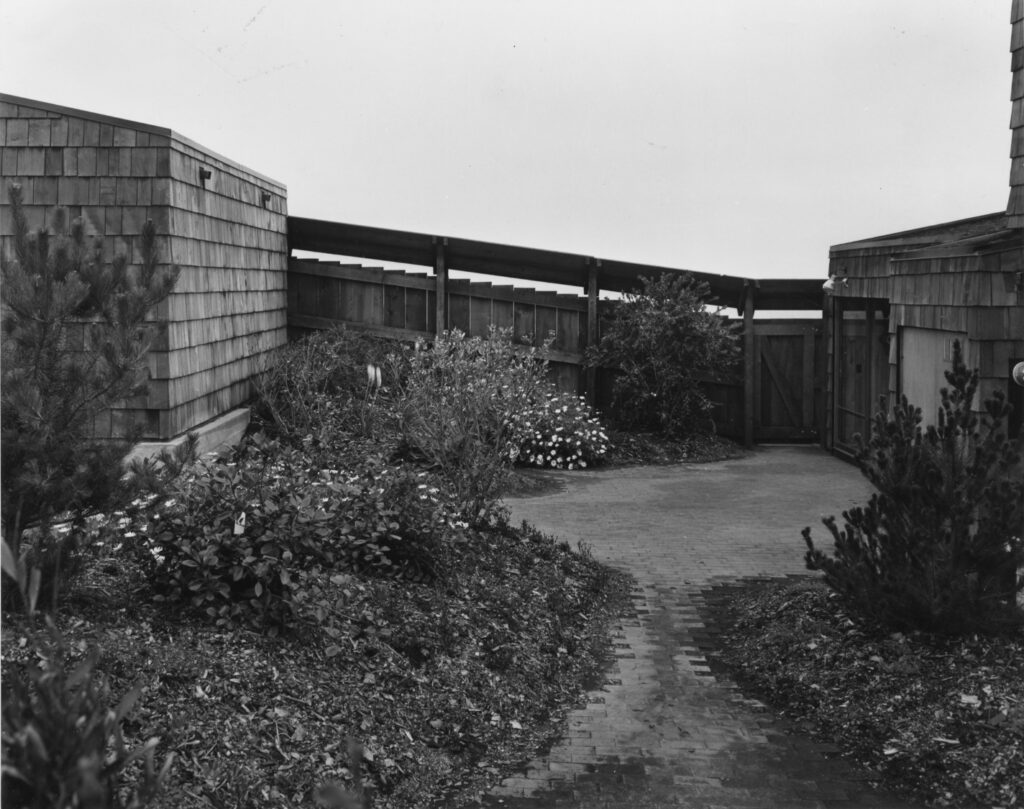
Caption: The Hedgerow houses have a shared identity, loosely connected by fences and green space.
Other unifying exterior details include a lack of roof and window eaves and cladding of redwood shingles left to weather. Whereas Condo One follows the slope of its site, Esherick’s Hedgerow Houses were tucked into the land. This is particularly evident in the single-story homes, such as Hedgerow #4 and #5, which are built into berms of earth. With foundations below grade, residents look into rather than over the surrounding meadow when sitting on the sofa, protected and cozy in stormy weather. These two homes were also built with sod roofs, further visually connecting them with the meadow.
The southern-most homes were built into the existing hedgerow. Others project into the meadow, as with Hedgerow #5 and Esherick’s own home, Hedgerow #6. All houses stand on modest-sized pieces of property, with the expansive commons/meadows beyond shared by all.
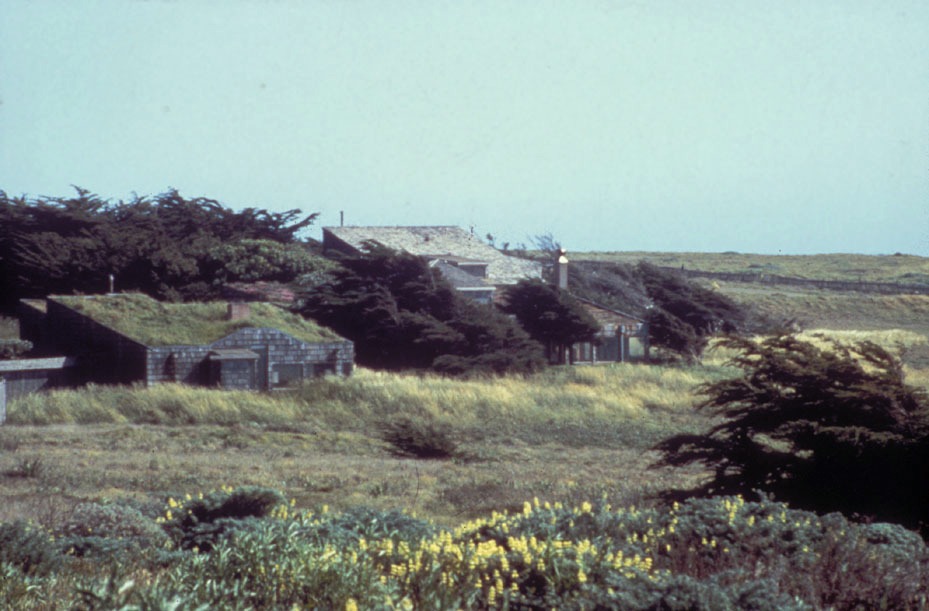
Caption: The Hedgerow Houses were built into the existing hedgerow. In the foreground, Joe Esherick’s own house has a sod roof, visually connecting the home to its surrounding landscape.
The Hedgerow Houses were built as small and compact weekend retreats, reasonably comfortable, but very straightforward. The floor plans for the single story homes are similar, but with some variation. In the basic design, private spaces (bedrooms and baths) are separated from public spaces by a hallway. Soaring ceilings reach upward, rising from the lower level that forms the beginning of the shed roof and meet the outdoors at the other end of the house. Three-sided glazed “pop outs” in some of the dining rooms enable meadow and ocean views. Some houses have small lofts that provided a special retreat to those agile enough to climb the ladders.
Detailing within all the houses is essentially the same. Most walls are paneled with rough sawn cedar, doors and windows lack molding, floors are concrete over radiant heat coils, and kitchen cabinets were ply board panels.
The Hedgerow Houses were built by Matt Sylvia, who moved from Southern California where he had previously worked with the renowned architect Richard Neutra and came to know Oceanic’s Al Boeke. Esherick himself, with the help of Homsey and others from the Esherick firm, did the build out of the interior of his own house, Hedgerow #6, resulting in differences in the quality of materials and precision of detailing when compared with the spec houses. Over the years many of the Hedgerow Houses have been added onto or remodeled to enhance views and living space, while at the same time owners have striven to maintain the Esherick aesthetic in these historic homes.
Read more about EHDD’s history and founding architects.
Written by Deloras Jones, a resident of Sea Ranch, and edited by Christine Kreyling
References:
- George Homsey, “Dinner with George,” a series of oral history interviews (2010-13); as well as conversation between George Homsey and Deloras Jones
- Donyln Lyndon and Jim Alinder, The Sea Ranch. New York: Princeton Architectural Press, 2004, 2014.
- Marc Treib, Appropriate: The Houses of Joseph Esherick. San Francisco: William Stout Publishers, 2008.
Climate Positive: Design and Advocacy
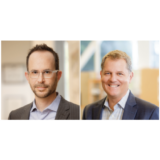
Some say it is too early to focus on anything but COVID-19. We say this is a once-in-a-lifetime opportunity to refashion our work, and our lives, towards a vision of a better world. We will pick up the pieces: how we put them back together is up to us.
We are struck by the parallels between COVID-19 and our larger, slower-burning Climate Crisis, by the consequences of inaction in the face of science, of underfunding vital research, of insufficient and slow response. In light of the urgency for action commensurate with the scale of the climate change challenge, and the need for a clear vision for the built environment moving forward, EHDD is committing to advancing what we are calling Climate Positive design across our portfolio.
Debra Roberts, the IPCC Co-Chair, warns us that “the next few years are probably the most important in our history… Limiting global warming to 1.5°C require rapid, far-reaching, and unprecedented changes in all aspects of society.” The challenge is one of speed and scale. A few exceptional buildings by elite firms will not get us there. We need strong policies, transformative innovations, and replicable approaches that lift all boats.
Our vision will be advanced in concert with our clients and collaborators towards the ultimate goal of a built environment that is genuinely Climate Positive by 2030. If EHDD’s portfolio can get there by 2030, we hope California can do so by 2040, and the rest of the US by 2050. To say this is ambitious is a grand understatement: it is the most significant transformation since the dawn of the industrial revolution.

Here is our opening salvo in five parts:
1 ELECTRIFY EVERYTHING
- No on-site fossil fuels
- Maximize efficiency and PV
- Design to use energy when it is clean
2 DECARBONIZE MATERIALS
- Reduce concrete and steel impacts
- Design systems and landscape for carbon sequestration
- Seek profound material innovation
3 REIMAGINE WHAT EXISTS
- Design transformation for existing buildings
- Avoid new embodied emissions
- Retrofit for high performance
4 RESILIENCE FOR A CHANGE
- Recognize the risks of a changing climate
- Design robust, passive, localized systems
- Integrate battery-PV in microgrids
5 LEADERSHIP THROUGH ADVOCACY
- Advocate for all-electric codes
- Speed and scale are essential
- Support advanced policy through a real-world perspective
- Partner with allied organizations
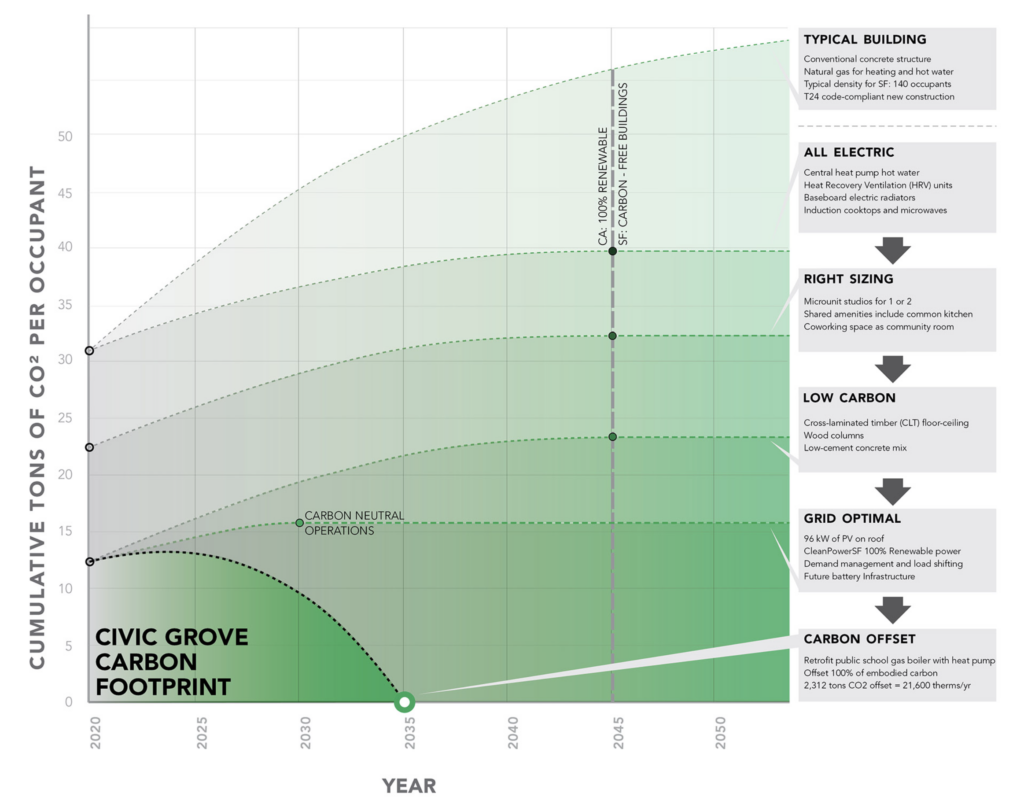
To execute on this vision, here are three of the key actions we are taking right now:
Perform carbon assessments on all of our projects
As an industry, we are where we were roughly ten years ago on energy modeling. At that time, very few knew what an EUI was let alone if 25 or 250 kbtu/sf/yr were good targets for an office or lab building. Today we need to understand the actual carbon impacts of our buildings, no matter where the carbon originates. We need to build literacy around what big levers exist and how operating and embodied emissions compare. You can only manage what you measure.
Focus on radical reductions in structure-based emissions
We will continue our encouraging work on mass timber and ultra-low cement concrete while partnering to explore new structural solutions and breakthrough innovations that we sorely need. These up-front emissions are our most significant opportunity to take big leaps immediately when we need it most.
Advocate to advance all-electric codes
Over the past two+ years, we have spent many nights attending city council and planning commission hearings, explaining how our industry is ready today for ALL buildings to be run on clean electricity. Our local political leaders are looking to us for advice and guidance on how to reach decarbonization goals that are effective and equitable. We ask you to join us in publicly advocating for new codes and policies to quickly transform the built environment.
Through concerted action, we can achieve a triple-bottom line, mutually reinforcing benefits such as:
- Revive urban economies by creating 24/7 downtown hubs of activity
- Speed the transition to an all-electric, decarbonized economy through wholesale modernization of outdated office buildings
- Increase both market-rate and designated affordable housing supply and meet our California “Housing Element” commitments
- Avoid upfront, embodied emissions associated with new construction and create a real pathway toward creating zero emissions built environment
- Support contemporary lifestyles and demographics through diverse unit types matched to unique existing footprints
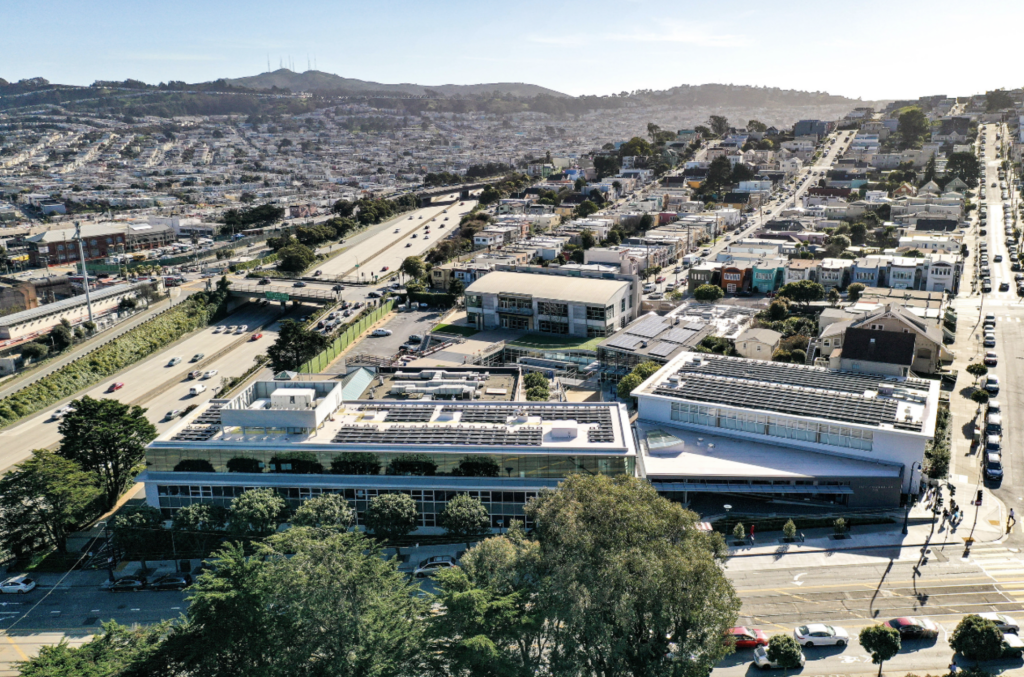
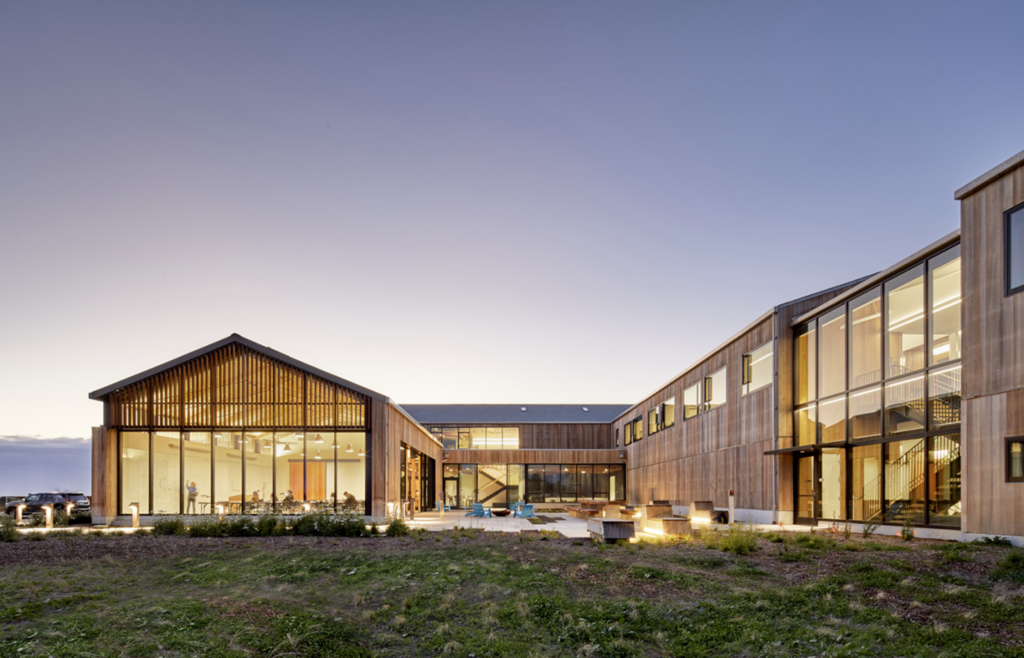
EHDD’s Christmas Tree: More is More

My beau ideal of a Christmas tree is the Angel Tree in the Metropolitan Museum of Art; but as I can’t have that, I create trees that are dense with other objects I love. This is my sixteenth tree, as I’ve been decorating trees at EHDD every other holiday season since 1987.
The Tree
I decorate natural trees, with natural shapes and scent. I avoid trees that have been shaped into smooth cones by chainsaws, ruining the ends of their branches.
Dense ornamentation requires a fairly open tree with clear, tall tiers and strong branches, such as our Silver Tip (from East Bay Nursery in Berkeley) or a Noble Fir, which tends to be denser. I prune some minor or spindly branches so that one can see and hang ornaments to the trunk. A few big holes or gaps in the foliage are necessary – they allow room for the largest ornaments, which anchor the composition. If the natural gaps aren’t large enough, one can prune to enlarge them.
Crooked trunks can be both visually interesting and useful; if the crook is at the top, as in this tree, that allows a large top ornament to be more centered on the main trunk below.
Clustering and Variation
The biggest and the best ornaments are anchors around which the rest of the ornaments are arranged, to reinforce or accent the anchor ornaments by clusters of color, texture, and kind. I group similar ornaments of different sizes, such as the silver mercury glass spindles, or several of the same ornaments at different heights, avoiding uniformity.
The tall spaces between tiers of branches allow this variation in height, avoiding the ‘laundry line’ of ornaments hung by the same length of the hook. Instead of hooks, I hang ornaments with fishing line, so that the height is completely adjustable – sometimes extending down more than a tier.
Ornaments can be placed or tied on top of branches, not just hung from them, and clustered around the trunk. Bunches of small paper roses are especially useful for twining around the trunk — masses of color at the center of the tree, hiding the dense support structure of the fishing line.
Atypical Ornaments
Almost anything can be used as an ornament if it is beautiful, light-weight, well-made, well-colored, and not too valuable to risk. My atypical ornaments include many Japanese dolls, sake pots, and tamari balls; Chinese kites, lanterns, pearls, and wheat straw model buildings; paper and fabric roses, toys, children’s paintbrushes, swizzle sticks, cotton snow, and ribbons.
Big paper cut-outs, such as the gold suns on this tree, are very light-weight and can be hung on the very ends of branches. This is especially useful when visual mass is needed where a heavier ornament wouldn’t work.
Very heavy ornaments such as the Japanese dolls and horses are possible when supported by the trunk, either directly tied to it, or hung where branches are guyed back to the trunk.
Shades and Hues
Orange, yellow, pink, white, frosty light blue, silver, and gold all show well on a tree.
Classic Christmas red is similar in value (darkness) to green tree needles, so I prefer it for only accents or a few clusters, rather than the main color.
Black can be an effective accent color; the black-and-white striped bows are ‘palate cleansers’, in contrast to the many other colors. Masses of black are especially visible when eclipsing bright colors behind them.
I even include some ornaments that have “less-than-ideal colors”, i.e. the grays of the Star Wars starships, chasing each other around the bottom tier. But, in this case, a large black tamari ball stands in for the Death Star.
Some Assembly Required
A tall and densely decorated tree requires organization and preparation. After the tree is pruned and the lights installed, I guy all the branches back to the trunk with the fishing line, so that they can support the significant weight without sagging. I use 30 lb. fishing line for the guying and for hanging the heaviest ornaments, and 15 or 8 lb. for lighter work.
Before hanging, I unpack all the ornaments and lay them where I can see and select them as needed. Then, in order, I compose and install:
- The very top-heavy or central ornaments (tall ladder work)
- Anything tied to the trunk, including paper roses
- Ribbons at the ends of branches and strings of pearls
- Any remaining tall ladder work, as the lower branches have ornaments that might be damaged by the ladder.
- The remaining ‘anchor’ ornaments
- Clusters of ornaments
- Lowest hung ornaments
- Ornaments tied to the tops of branches (such as Japanese Hina dolls)
- Additional roses on trunk and branches as needed to reinforce clusters of color
- Skirt and toys on the floor
Safety First
I recommend LED lights for their safety (even if older lights are still working), and a solid tree stand. For a large tree such as this one, a welded stand with a large integral water reservoir is ideal.
In San Francisco commercial spaces, see the San Francisco Fire Department Information Bulletin regarding ‘Use of Christmas Trees in Regulated Occupancies’. Fire-retardant treatment of natural trees, and/or fire sprinklers, may be required.

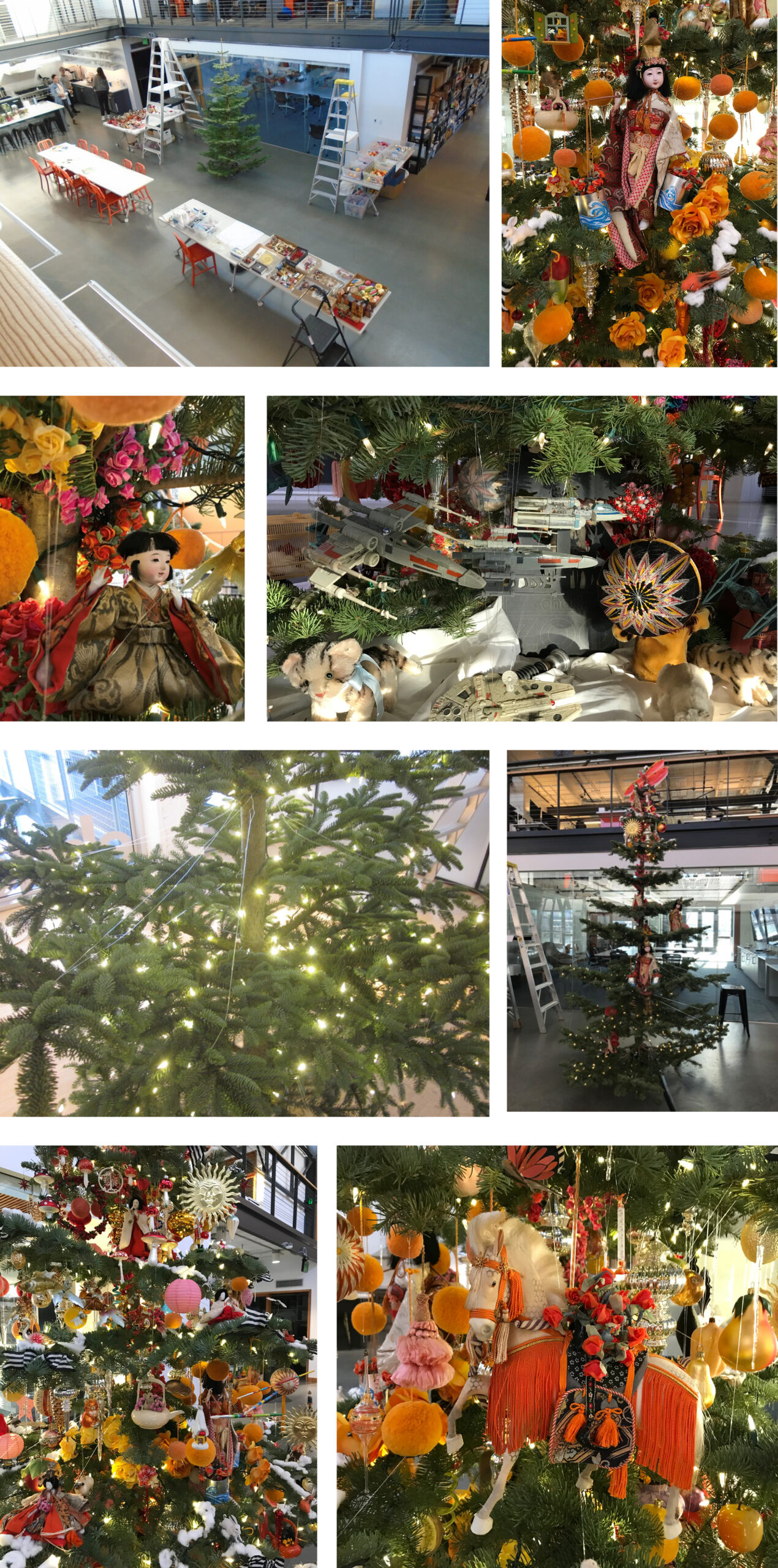
World’s first “GridOptimal” building is Sonoma Clean Power’s headquarters
Published: Sept. 20, 2022 | FOR IMMEDIATE RELEASE
Santa Rosa, California — Sonoma Clean Power (SCP) recently unveiled its new all-electric headquarters which features an innovative microgrid and goes far beyond “net zero energy” standards by reducing greenhouse gas emissions on the State’s electric grid.
Located at 431 E Street in Santa Rosa, California, the two-year renovation transformed a 1979 structure into the world’s first GridOptimal® building that enables and accelerates decarbonization of the grid. Unlike traditional net zero energy buildings, SCP’s headquarters consider exactly when it produces and uses power.
The building’s 23 electric car chargers, building lights, HVAC, and water heating can all adjust when they use electricity to ensure that energy is only drawn from the grid when plenty of clean power is available in California. The battery system typically charges up around noon when there is an abundance of solar power. During the evening, the building can then use that energy or place it back onto the grid to reduce the State’s reliance on polluting gas power plants.
“After eight years of growing our team and expanding our mission, we’re able to show what an advanced energy building looks like in practice with the most efficient and climate-friendly facility we know how to build,” said Geof Syphers, CEO of Sonoma Clean Power. “Our new headquarters is a ‘test case’ that’s working well, and we want people to know that this can be replicated- that clean electricity and decarbonization are attainable today. We also want people to understand that a 24/7 zero-emissions future for buildings is achievable and practical.”
SCP’s new headquarters is the first pilot project for the Grid Optimal® Buildings Initiative, a joint program of the New Buildings Institute and the U.S. Green Building Council. The program aims to redefine how building design and operations can cost-effectively support the decarbonization of the power grid and a fully renewable electricity supply.
Using an hourly signal of grid emissions, the building’s flexible microgrid adjusts when to pull from the external power grid or its on-site 220 kWh battery system. This allows it to store and utilize renewable energy, and even supply power back onto the grid at times when other buildings need it. The microgrid also can operate portions of the building when the grid is down and serve as an emergency operations center during a local disaster.
The all-electric building is partially powered by an on-site solar array with the rest coming from SCP’s 100 percent renewable and locally generated EverGreen service. Its exceptional air sealing and strict energy and water efficiency criteria far exceeded the highest standards in sustainability and health. The former natural gas infrastructure was removed for space heating and hot water, and the kitchen was refitted for advanced instruction cooking.
“Sonoma Clean Power’s new headquarters is an exciting example of how yesterday’s buildings can be repositioned to blaze a trail toward the clean, flexible, healthy, resilient buildings of tomorrow,” said Alexi Miller, Acting Director of Building Innovation at New Buildings Institute. “This GridOptimal pilot project led the way through both passive and active building-grid integration strategies. The building’s designers focused on targeted energy efficiency measures that reduce power demand during high-cost, high carbon times. Meanwhile, the solar plus storage microgrid system and smart controls work together to enhance demand flexibility, while reducing operating costs and cutting carbon emissions. SCP’s leadership is inspiring, and we look forward to more buildings following their example.”
The building serves as an elevated workspace for employees complete with daylighting, fresh air systems, and operable windows. Thoughtfully curated natural materials and furniture were selected to comply with strict environmental standards. Two 200-year-old oak trees on the property were carefully protected through construction, and now help cool the building during the summer.
The project was designed by EHDD Architecture to create a lively welcoming space out of an old, dated office building while showing how even simple updates can reduce a building’s carbon footprint. This induced reorienting the entryway to maximize daylighting and installing large ceiling fans to extend the rand of comfort conditions in the space when necessary to support building load curtailment. Guttman & Blaevoet served as the project’s lead building infrastructure and sustainability engineer, with conceptual support from the engineers at Point Energy Innovations.
Midstate Construction was the project’s general contractor and Sixth Dimension was the construction manager. The Project’s design began in 2018, with construction completed in 2021. The microgrid installation was completed in mid-2022.
About EHDD
EHDD is an award-winning architecture firm with a strong commitment to advancing climate action through sustainable design. With decades of experience and numerous successful projects, EHDD creates transformative places of belonging and impact.
About Sonoma Clean Power
Sonoma Clean Power is the public provider for Sonoma and Mendocino counties, serving about half a million people. In downtown Santa Rosa, SCP operates the only Advanced Energy Center in the United States dedicated to helping customers transition to 100% renewable energy for their homes, businesses, and vehicles. SCP is also the only power provider in California offering 100% local, renewable electricity twenty-four hours per day, every day of the year. To learn more, visit sonomacleanpower.org or call 1 (855) 202-2139.
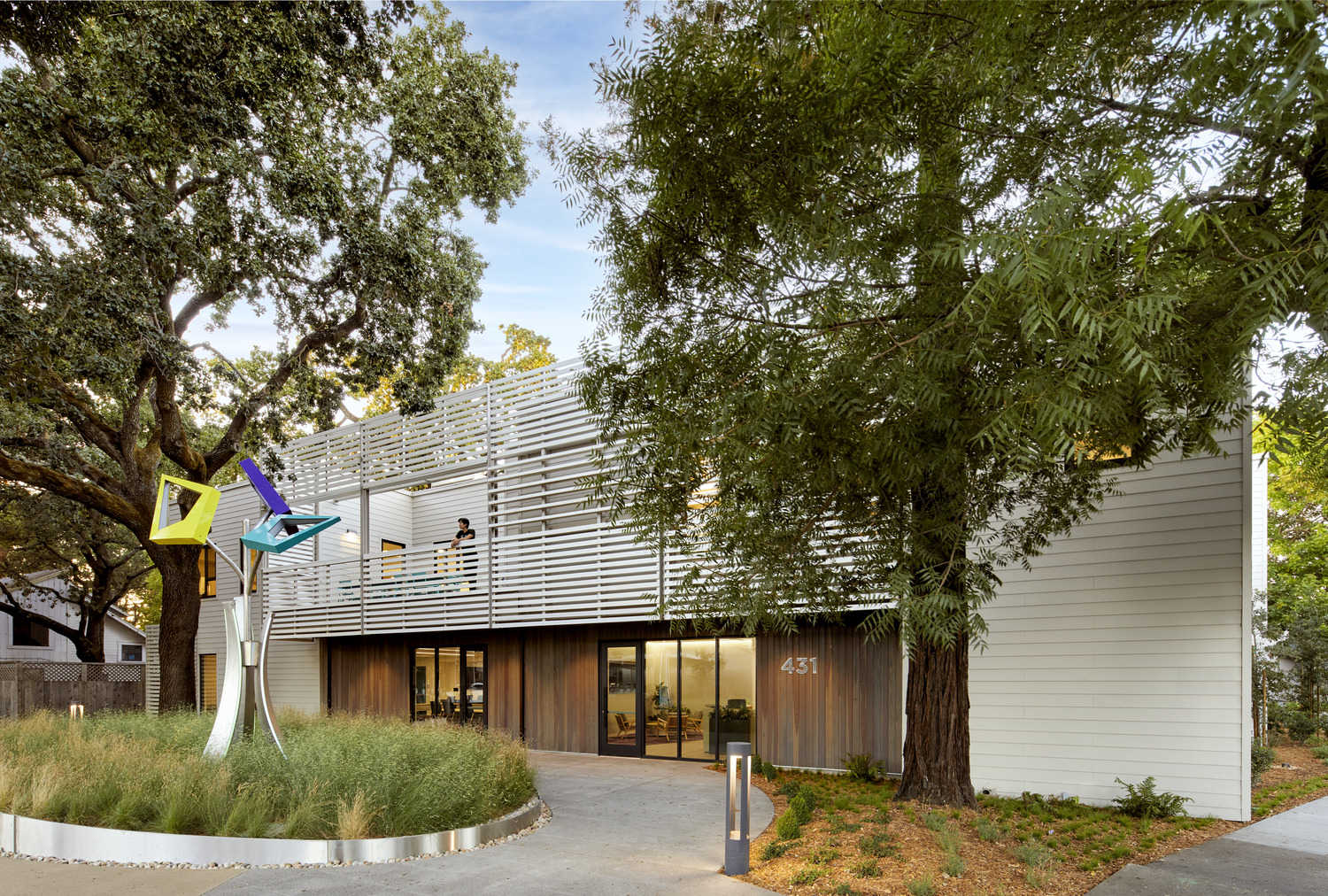
Jennifer Devlin-Herbert to Lead EHDD’s Future Growth as the Design Firm’s First Female CEO
New leadership approach sets the scene for growth and evolving client and community responsiveness.
San Francisco, California and Seattle, Washington (September 12, 2022) – A distinguished design leader, community builder and skilled collaborator, Jennifer Devlin-Herbert, FAIA, has been selected by her Partners to lead EHDD for the next stage of the firm’s evolution. Recognized for her award-winning work and focus on clients’ visions, Devlin-Herbert has championed a culture of continuous learning and mentorship. In other EHDD leadership changes Duncan Ballash moves from President to CFO, and Brad Jacobson fills the new role of COO.
With its reenergized structure in place, EHDD will focus on expanding its Seattle presence, increasing collaboration and knowledge-sharing between its Seattle and San Francisco studios, and broadening the visibility of its work with cultural, commercial, civic and educational institutions, all underscored by a commitment to serving diverse communities. In so doing, it will bring to life its new mission of: Creating Transformative Places of Belonging and Impact. To support this mission, the new EHDD management team is renewing its strategic direction and commitment to designing for a climate positive future together with its 75+ member team who are poised to reflect the values in their work.
“Jennifer is the link between the culture set by our Founder and our work today. Her innovative design and engagement approaches have made EHDD a leader in the profession over the past decade,” says Ballash. “She is dynamic, engaging and brings the unique ability to embrace complexity and differences, while mobilizing disparate groups. She cultivates collaboration in the communities where we work.”
Devlin-Herbert joined EHDD in 1994, became the firm’s first female partner, and is now its first female CEO. She joins a small but growing cohort of women leading architecture firms and exemplifies EHDD’s commitment to equity. With this appointment, the firm will be guided by her approach that blends a passion for creating innovative and functional designs with deep engagement at the local community level. “Duncan has set the stage for this next chapter at EHDD, having led us in the role of President for over 15 years. In that time, we have proven that our work can be transformative for communities,” she says. “For EHDD, ‘innovative design’ means focusing our team’s talents to create work that delights our clients – and doing this in conversation with the communities where we build. Our challenge is to enable change in communities that don’t believe they have a voice; it’s a continuing opportunity to learn and understand how to be part of the solution.”
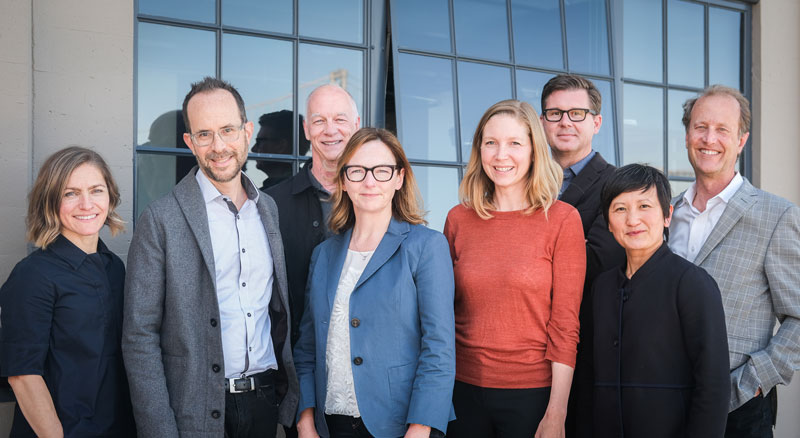
EHDD Democratizes Decarbonization with EPIC tool
Published: June 30, 2022
On June 21, 2022, EHDD Architecture launched the Early Phase Integrated Carbon Assessment (EPIC) tool as a web application. This milestone came after two years of development, validation, review, and a good deal of uncertainty. When we started, EPIC was a moonshot: could a lightweight whole-carbon model support early decisions and strategies for deep carbonization?
The answer is an emphatic YES. We’ve realized the potential of EPIC as an early-phase tool in our own pursuits and projects, like the zero carbon AIA headquarters renovation, and we now use the tool across our firm’s work. It also became clear that we should not keep EPIC to ourselves, nor lock it up behind a paywall. We need collective effort, scale, and speed to catch up with the climate crisis. To support our Climate Positive commitment, EHDD is making EPIC available for free to everyone – architects and engineers, building owners, campus planners, and real estate developers – as we all work together to decarbonize our built environment.
We designed EPIC and offered it for free to democratize decarbonization. We’ve done our best to keep the app simple to use, its results easy to interpret, and its data and methods accessible. Bridging between a complex data model and a simple user experience, EPIC illustrated that every project has a pathway to lower carbon emissions. And as EPIC guides projects toward decarbonization, project teams can focus on how carbon emissions reductions connect with improving human health, creating social equity, and restoring ecological function.
Our public launch of EPIC is a stepping stone, not a conclusion. New data is becoming available while methods and expectations for carbon assessments are developing rapidly. User feedback will continue to guide EPIC’s development, keeping the tool turned to the most impactful decisions.
We are beginning to extend EPIC for use in larger-scale planning processes. As campuses, corporations, and developers set carbon neutrality targets, forward-looking projections of operational and embodied missions become essential elements of development and capital improvement planning. This emerging version of EPIC will allow for lightweight and dynamic projections of climate impacts to plan decarbonization at the campus or the portfolio scale.
EPIC, as an early phase tool, opens conversation within a project. With its public launch, we hope to expand the conversation across the whole industry.
If you’re looking to learn more, reach out.
Interested in EPIC? Use the tool for free at epic.ehdd.com.
